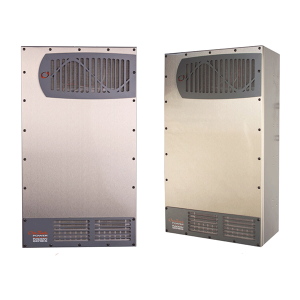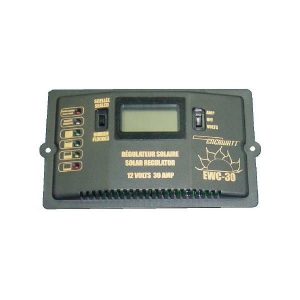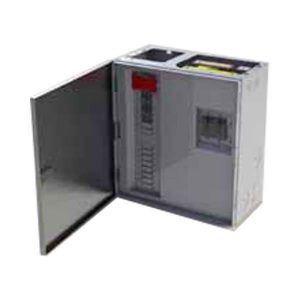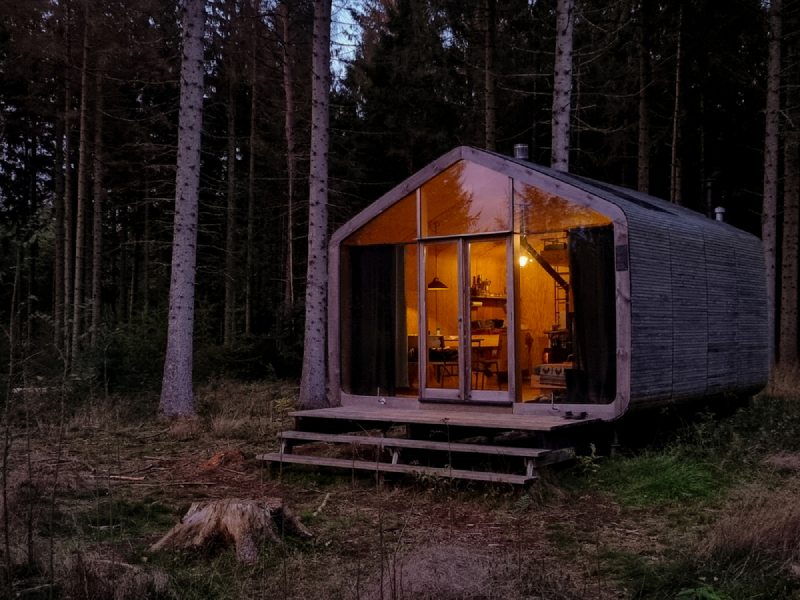
If you’re ready to lead an independent lifestyle, an off grid solar system in Canada might be the solution. Free yourself from unexpected rate increases, monthly utility bills, and fossil fuel consumption with off-grid solar power.
Maybe you’ve always been curious about off-grid solar, but you’ve been waiting for the right time to take the plunge. There’s no better time than the present. Disconnect from the limitations of dependence with an off-grid solar system.
In this comprehensive guide, we’ve set out to answer your top questions about setting up an off-grid system. We’re going to cover the approximate costs, maintenance, and components required for a successful solar system. Here’s what you need to know about Canadian off-grid solar in 2022:
What Is an Off-Grid Solar System?
Before we dive into this guide, we’re going to explain how an off-grid system works:
It all starts when sunlight hits your solar panels. Through the photovoltaic effect, those panels absorb and convert sunlight into electricity. Energy flows from the panels into a battery bank.
The batteries store electricity until it’s needed, at which point the energy is sent to an inverter. This system converts the DC electricity (direct current) into the AC electricity (alternating current) that most of your household appliances use. Any leftover electricity is stored in the battery.
The unique thing about off-grid solar is that it’s entirely independent of the power grid. These systems are self-sufficient, meaning you won’t be reliant on a utility company for electricity.
What Does It Mean To Go Off the Grid?
When we talk about “the grid”, we’re referring to the power grid that supplies the homes, businesses, and vehicles in your community with electricity.
When you set up an off-grid solar panel system, you will be entirely disconnected from that power grid. You won’t be able to send or receive electricity from it. Instead, your personal solar system will be designed to generate enough electricity to meet your energy needs.
Keep in mind that when you’re completely off the grid, you can’t access any power from it. That means if you run out of solar energy, you’ll be completely reliant on the backup storage from your batteries. This is why it’s so important to size your off-grid system accurately; otherwise, you could run out of power when you need it most.
Do You Need Permits To Build off the Grid?
Depending on where you live, you may need a permit before you can set up your solar system (even if you own the land you’re building on). We recommend that you check the local regulations in your area before you start installing a solar panel system.
Off-Grid Solar Systems Cost By Size
Now, we’re going to get into what your solar setup will end up costing you. Keep in mind that these estimates do not include installation costs. If you’ve already determined how much energy you use and the size of the solar power system that you need, use this list to gauge its approximate cost:
1200 Wh (1.2 kW) Solar System
A system of this size isn’t enough to power an entire home. However, you could use it to supplement your other independent energy sources, like wind turbines. If you aren’t ready to detach from the grid just yet, this system can help you reduce your reliance on it. At SRB Energy, we sell this system for $5,738.
3600 Wh (3.6 kW) Solar System
This system is suitable for a tiny home with low energy needs. You need to live in a sunny climate for this off-grid system to provide sufficient solar power. If you have relatively low energy usage and you live in a location with plenty of sunshine, this might be the right system for your needs. It will cost around $14,925.
4550 Wh (4.5 kW) Solar System
Take your remote cabin or tiny home off the grid with this setup. Like the previous options, this kit relies on a sunny climate and moderate to low energy usage. If you’re conservative with your energy consumption and you live in the right location, you can use this solar system to power your home for $19,060.
7500 Wh (7.5 kW) Solar System
For most houses, this system will provide sufficient solar power to meet your energy needs. It can run loads for 2 days without sunlight and power appliances like a small fridge, coffee machine, and washing machine. The cost is $21,351.
15,000 Wh (15 kW) Solar System
Do you live in an area with a cloudy climate? Is your energy usage higher than the average household? If so, consider this solar system for your off-grid home. It’s perfect for a moderately sized home with appliances like an internet modem, blender, and stereo system. You can buy a complete off-grid solar kit of this size for $42,060.
30,000 Wh (30 kW) Solar System
For businesses with high energy usage, this solar setup is the way to go. You can trust that you’ll have enough power to meet the electricity demands of a commercial business. Or, use this system in your household to power the most demanding appliances, including furnaces, air conditioners, and ceiling fans. For a system of this size, you can expect to pay around $124,646.
Off-Grid Solar Cost By Type
Your solar system is just as unique as the location you live in. Depending on what you want from your off-grid setup and how much power you need, you might choose one type of system over another. We’re going to explain the different types of solar panel systems you can choose:
DC Solar Panel System
Send the power from your solar panels directly to your home with a DC system. With this setup, you can save on the cost of an inverter and batteries.
Of all the different types of systems, this one is the most affordable, but it also creates the least amount of electricity. Another downside is that without a battery, you can’t store energy for later usage, so it’s not ideal for an off-grid system. You’ll be limited to appliances that use DC energy as a power source.
DC & AC Solar Panel System
You can choose a hybrid setup if you have some appliances that rely on AC energy. It will be less expensive than a complete AC system and will produce more power than a DC-only system.
AC Solar Panel System
Convert DC energy into AC energy with this solar array. To set it up, you’ll need the following equipment:
- Inverter
- Battery bank
- Solar panels
This setup is ideal for those with high energy demands. Due to the equipment required for this setup, it tends to cost the most. When you convert DC to AC energy, you can power more of your household appliances and electronics; it’s an ideal setup for an off-grid home or cabin.
AC Solar Panel System with Wind
When you choose this type of solar setup, you need to factor in the additional cost of a wind turbine. You also need a battery bank to store the wind and solar panel energy. However, you can use wind energy to supplement some of your electricity needs, so you may not need to purchase as many solar panels.
Off-Grid Solar Cost By Component
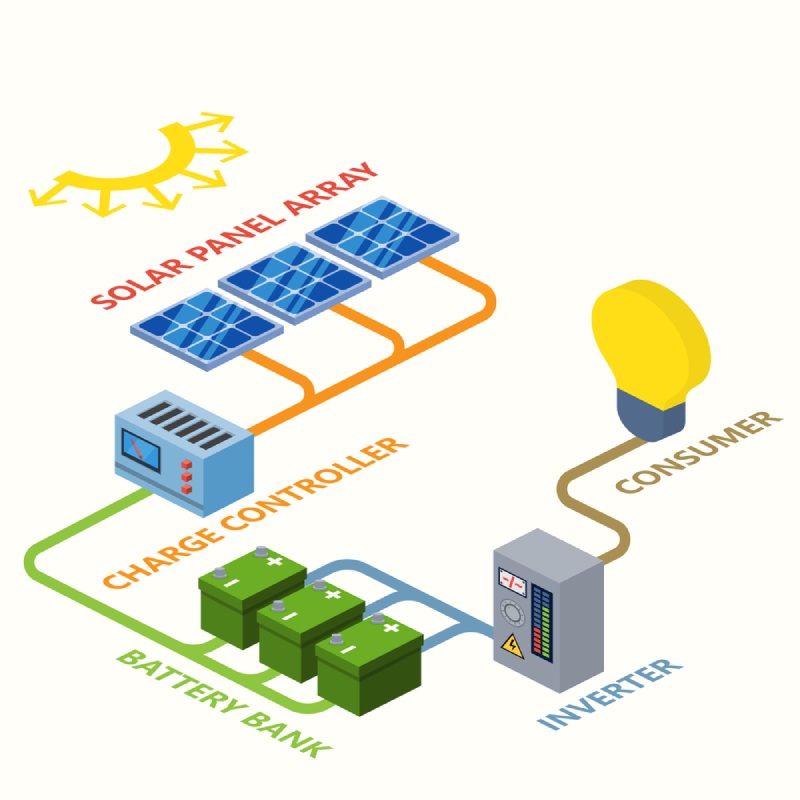
You need more than solar panels to get your off-grid solar system up and running. An off-grid system consists of many different devices, all of which work together to generate ample electricity for your home.
When you’re budgeting for your solar panels, you need to factor in the cost of these components:
Charge Controller
Just like with our phones and laptops, it’s not good to overcharge a battery; doing so can damage the battery cells. To prevent overcharging and maximize the power output of your solar panels, you need a charge controller. This device protects the health of your batteries.
There are two types of charge controllers:
PWM Charge Controllers
Pulse-width modulation controllers regulate the charge of your battery using pulses of energy. When the battery is full, the charge controller reduces how much power it sends to the battery. It sends a small amount of power to keep the battery full without overcharging it.
This setup requires your solar panels and batteries to have matching voltages; otherwise, the controller will not work as effectively. For these reasons, they’re often used with smaller solar systems.
PWM controller controllers are generally less expensive than MPPT ones. However, that comes at the cost of reduced efficiency. Depending on the voltage you’re looking for, the price of a PWM charge controller can vary. A 30A PWM charge controller by Midnite Brat costs $173.
MPPT Charge Controllers
Maximum power point tracking charge controllers will maximize the output of your solar panels while still preserving battery health. The device continually monitors how much energy your panels are producing, along with the battery capacity. Using this information, the charge controller modifies the energy it feeds into the battery to maximize the energy that’s produced.
MPPT charge controllers are more expensive than PWM ones. A 30A MPPT charge controller by EPSolar costs $337.
Battery Bank
What happens if you run out of solar energy? When you’re off the grid, you have no other source to draw electricity from. You rely on a battery bank to store additional power for days like these.
Battery systems are what make it possible for you to take your solar panels off the grid. You can draw from them when your energy needs are higher or after the sunsets. There are a few different types of batteries you can choose from, each with different price points:
- Lead-acid batteries. Also known as flooded or sealed lead-acid batteries, these batteries are a bit more affordable than lithium ones. Keep in mind that they require more maintenance and won’t last as long as a lithium battery. You can purchase a 6V Surrette Dual Wall Container Solar Flood Battery for $1,167.
- Lithium batteries. This is the same type of battery that’s used to power your cell phone (but to store solar energy, you’ll need a much bigger one). Lithium-ion batteries come with the highest price tag, but that’s due to their long lifespan, low maintenance, and safety. A 24V Lithium Battery by Rolls costs $6,472.
Mounting System
Where do you plan to install your solar array? You can mount your solar panels to a roof, the ground, or the top of a pole. If you choose a roof-mounted setup, the number of solar panels you can install will be limited by the size of your home.
For larger solar systems, it might be better to use the ground on your property or a top-of-pole mount instead. Depending on which type of mount you choose, costs will vary.
Solar Panels
Now it’s time to consider the type of panels your system needs. Of all the components you purchase, the panels will probably cost the most. It’s important to choose the right type of panels; they determine how much energy your system will produce, how efficiently it converts sunlight into electricity, and how long it will last.
Polycrystalline solar panels are more affordable than monocrystalline ones. For reference, a 320W 60 Cell Monocrystalline Solar Module by HES is $336., while a Hanwha 354W 72 Cell Polycrystalline Solar Module is $296.While monocrystalline solar panels are more expensive, they also have a higher efficiency rating.
Are you limited on roof space? A monocrystalline panel will produce more solar energy in the same amount of space. They’re a better choice when you’re limited by your roof size.
Wind Turbine (alternate energy source)
On cloudy days, there are other ways to supplement your energy needs. You can install a wind turbine to produce additional electricity for your house, cabin, or tiny home. Like solar power, wind turbines are another eco-friendly way to produce energy and eliminate your reliance on the power grid. You can purchase a 12V AIR Wind Turbine for $1,888.
The cost of buying each component separately adds up quickly. At SRB Energy, we sell off-grid packages that include everything you need to get started, including panels, cables, battery banks, and more.
Labour Costs To Install an Off-Grid System
The labour costs involved with an off-grid solar system aren’t inexpensive. And the larger your system is, the more expensive those costs will be. Here’s a glimpse at the labour that’s involved with installing these systems:
- Connecting each component of the system
- Choosing the location and position of the panels
- Setting up the solar modules, charge controller, and battery
- Connecting the system to your home
If you’re looking to save on installation costs, you might wonder if there’s another way. Have you considered installing the system yourself? Our solar kits come with every component you need for your off-grid solar power system, including detailed instructions and warranties. At SRB Energy, we’ll be there to help you along each step of the way.
How Many Solar Panels Are Needed To Run a House Off-Grid?
To answer this, you need to figure out the annual power consumption of your household. This will vary based on how many people you live with, the appliances you use, and the climate of the area.
First, determine how much energy you used last year. Take a look at your monthly electricity bills from the past 12 months, and add up the total kilowatt-hours. Keep in mind that those totals fluctuate from month to month (you can’t choose one month and multiply it by 12). Based on that total, you can estimate how many kWhs you need your solar panels to produce.
Next, consider the weather patterns of your location. If you live somewhere with a sunny climate, that will lead to higher solar power output. But if you live somewhere without much sunlight, your solar panels will generate less electricity. Therefore, you’ll need to install more panels to compensate for the lack of sunlight.
Once you’ve figured out how much power you need for all the appliances in your home, you can determine the number of solar panels you’ll require.
On-Grid vs. Off-Grid
Not sure which type of solar array you need? We’re going to clear up the differences between a grid-tied and an off-grid solar system:
On-Grid
Also known as a grid-tied or grid-interactive system, these solar systems are connected to the local power grid. When you generate excess electricity, you can sell it back to the utility company (depending on where you live, return rates will vary). On days when you use more energy than you produce, you can supplement your electricity with power from the grid.
Drawing from grid power is convenient, but it’s also expensive. You need to pay anytime you supplement your energy usage with electricity from the grid.
With an on-grid system, you’ll be limited to areas where you can connect to the power grid. This may not be the best option if you have plans to build a remote cabin.
Off-Grid
There’s nothing quite like the feeling of total independence. With an off-grid solar power system, you have the freedom to generate electricity wherever the sun shines. When you aren’t tethered to the grid, you’ll be free from rate increases and power outages.
Off-grid systems tend to cost more than on-grid ones. That’s because you need to pay for additional equipment, like a battery bank. Even though the investment will cost more upfront, it translates to better savings in the long run. Why? There are a few reasons for that:
- You won’t pay a dime for the electricity you use; all of it will be generated by your solar panels
- Rate increases will no longer cause your monthly bills to skyrocket
- If you work from home, power outages won’t interrupt your day, costing you lost productivity and time
Maintaining Your Off-Grid Solar System
You’ll be happy to know that it’s relatively simple to maintain a solar system. It’s one of the best things about having an off-grid system: Once you cover the initial installation costs, you hardly have to pay for upkeep.
In the winter, you might deal with snow piling up on your roof. But will this be an issue for your solar modules? Here’s the good news: snow build-up only slightly affects how much power your panels produce. The panels are installed at an angle, so the snow will naturally slide off them as the sun melts it.
If you have a ground-mounted setup, you can lightly brush off the snow using a non-abrasive cloth. But if the snow is on your roof, it’s safest to wait until it melts.
Not Every Property Is Right for Solar (Ideal Candidates)
Before you invest in solar panels, it’s important to consider whether it makes sense for your property. Many factors affect the efficiency of your system, including:
The Location
Is your house surrounded by leafy trees? The shade will limit the sun exposure of your solar panels, thereby reducing the solar energy they can generate.
The Climate
In your province, how many hours of sunlight do you get each year? As you might expect, the more sunlight you receive, the more power your solar panels will produce.
The Position of Your Panels
The quality of your solar panels is just as important as their angle and position. In Canada, it’s best to place each of the solar panels on a south-facing roof. If you don’t have a south-facing roof, it may be more optimal to use a ground-mounted setup instead.
The Components of Your System
An off-grid solar system will require the following:
-
- Solar panels
- A mounting system
- Batteries
- A charge controller
- An inverter
- Optional: A backup power source, such as a generator or wind turbine
If this much equipment is out of your budget, an off-grid solar system might not be feasible for you.
Advantages & Disadvantages of Off-Grid Solar
Is an off-grid system right for you? Or are you better off investing in one that’s tied to the grid? Before you take the plunge, consider these pros and cons:
Benefits of Off-Grid Solar
A few benefits of an off-grid system include:
- No more utility bills. Since you don’t draw power from the grid, you don’t have to pay for it. That means you’ll save money every month.
- No more power outages. The electricity grid might go down after an extreme weather event or when power lines need repairs. But with an off-grid setup, you’ll never deal with power outages again.
- No more rate increases. You’re tired of watching your electricity bill get higher year after year. With solar panels, you’ll never be subject to another unexpected rate increase.
And lastly, one of the main reasons why Canadians choose off-grid solar is because you can generate electricity anywhere.
No matter how remote your destination is, you can install a solar power system to meet your energy demands. Whether you’re building a tiny home, cottage, or a new house, you can use off-grid solar to generate all the electricity you need.
Downsides of Off-Grid Solar
The main disadvantage of this system is that you can’t draw on the grid when you run out of energy. Be sure to invest in a system that’s the correct size for your home. If you’re concerned about running out of solar power, consider buying an alternative energy source for your home, like a wind turbine.
And finally, you won’t be able to sell excess energy to the grid. This isn’t necessarily a downside; you can store the energy in a battery bank for later use.
Off-Grid Internet Solutions
Even if you long for a remote cabin, hidden away from the hustle and bustle of city life, you might still need the internet. It may be necessary for your job, and it helps you stay connected to your friends and family. How can you go off the grid but still get the reception you need?
As long as you live in an area with internet service, you can power a modem with solar power. But if you’re out of luck, consider upgrading to an unlimited data plan on your cell phone. Alternatively, you can find out whether satellite internet is available in your area.
Are You Looking for Solar Panels in Canada?
We hope our off-grid solar guide has helped you budget for the costs of your solar panels. Now that you’ve read up on off-grid solar panels, you might be interested in taking the next step and purchasing some for your home. We’re here to help with that.
At SRB Energy, we believe that every Canadian deserves access to solar power. That’s why we offer affordable and high-quality solar panel kits. Skip the installation costs with our off-grid solar packages. We carry top-of-the-line equipment with competitive pricing.
Check out our selection of high-quality products from reputable solar brands, including OutBack Power, MidNite Solar, Morningstar, and more. If you’re ready to take energy generation into your own hands, check out our solar products today!

